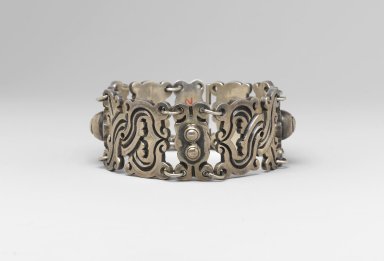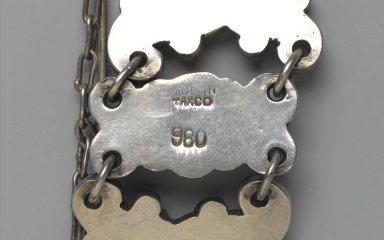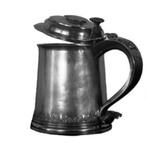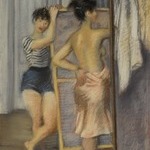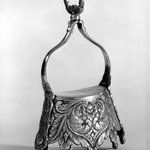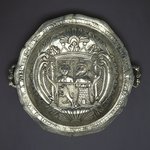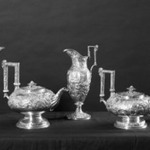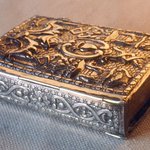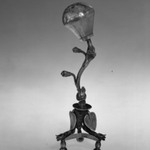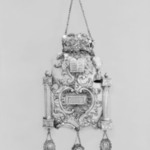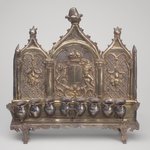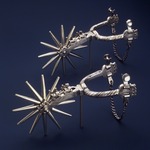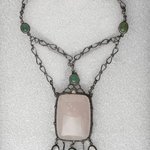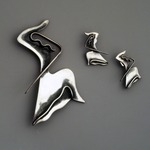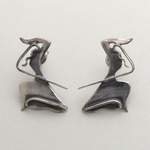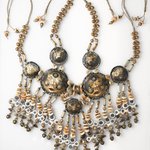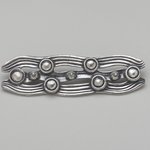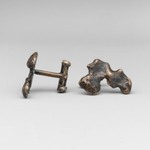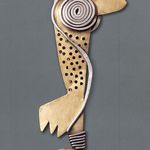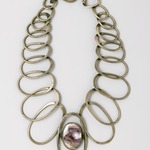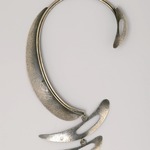Bracelet
Decorative Arts and Design
On View: Luce Visible Storage and Study Center, 5th Floor
Although one of the twentieth century's most prolific creators of handmade jewelry, William Spratling stood consciously outside the modernist movement thatt flourished during his career. Trained as an architect, he was introduced to the idea of jewelry making during sojourns in Mexico beginning in 1926. In 1929 he moved to Taxco, Mexico, the site of centuries-old silver mines, and set up a company of local artisans to revive the art of silver hollowware and jewelry. His designs were inspired primarily by pre-Columbian motifs. This venture became an enormous success, especially during World War II and immediately after when department stores in the United States were cut off from European suppliers of luxury goods. Unfortunately, Spratling lost control of his company to other investors, and by 1946 Spratling y Artesanos was out of business. Thanks to his apprenticeship system, however, his legacy continues in Mexico today.
MEDIUM
Silver
DATES
ca. 1935–1940
MARKINGS
Incised on reverse of a short link " [M]ADE IN/TAXCO" and "980".
ACCESSION NUMBER
2006.7.2
CREDIT LINE
Gift of Dr. Martin R. and Eve Lebowitz in memory of his parents, Henry and Esther Lebowitz
CAPTION
William Spratling (American, 1900–1967). Bracelet, ca. 1935–1940. Silver, 1 1/8 x 7 3/4 in. (2.9 x 19.7 cm). Brooklyn Museum, Gift of Dr. Martin R. and Eve Lebowitz in memory of his parents, Henry and Esther Lebowitz, 2006.7.2. Creative Commons-BY (Photo: Brooklyn Museum, 2006.7.2_PS2.jpg)
IMAGE
overall, 2006.7.2_PS2.jpg. Brooklyn Museum photograph, 2006
"CUR" at the beginning of an image file name means that the image was created by a curatorial staff member. These study images may be digital point-and-shoot photographs, when we don\'t yet have high-quality studio photography, or they may be scans of older negatives, slides, or photographic prints, providing historical documentation of the object.
RIGHTS STATEMENT
Creative Commons-BY
You may download and use Brooklyn Museum images of this three-dimensional work in accordance with a
Creative Commons license. Fair use, as understood under the United States Copyright Act, may also apply.
Please include caption information from this page and credit the Brooklyn Museum. If you need a high resolution file, please fill out our online
application form (charges apply).
For further information about copyright, we recommend resources at the
United States Library of Congress,
Cornell University,
Copyright and Cultural Institutions: Guidelines for U.S. Libraries, Archives, and Museums, and
Copyright Watch.
For more information about the Museum's rights project, including how rights types are assigned, please see our
blog posts on copyright.
If you have any information regarding this work and rights to it, please contact
copyright@brooklynmuseum.org.
RECORD COMPLETENESS
Not every record you will find here is complete. More information is available for some works than for others, and some entries have been updated more recently. Records are frequently reviewed and revised, and
we welcome any additional information you might have.
